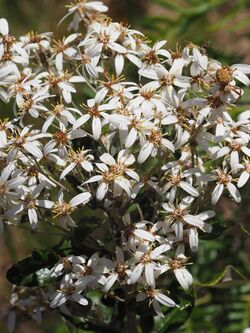Biology:Olearia oppositifolia
| Olearia oppositifolia | |
|---|---|

| |
| Near Cathedral Rock National Park | |
| Scientific classification | |
| Kingdom: | Plantae |
| Clade: | Tracheophytes |
| Clade: | Angiosperms |
| Clade: | Eudicots |
| Clade: | Asterids |
| Order: | Asterales |
| Family: | Asteraceae |
| Genus: | Olearia |
| Species: | O. oppositifolia
|
| Binomial name | |
| Olearia oppositifolia (F.Muell.) Lander[1]
| |
| Synonyms[1] | |
|
List
| |
Olearia oppositifolia is a species of flowering plant in the family Asteraceae and is endemic to eastern Australia. It is a shrub with egg-shaped to elliptic leaves arranged in opposite pairs, and white and yellow daisy flowers.
Description
Olearia oppositifolia is a shrub with erect stems that typically grows to a height of up to 2.3 m (7 ft 7 in). The leaves are mostly arranged in opposite pairs, egg-shaped to elliptic, 14–110 mm (0.55–4.33 in) long and 6–39 mm (0.24–1.54 in) wide, green on the upper surface and pale brown, covered with greyish hairs on the lower surface. The heads or daisy-like "flowers" are arranged in corymbs 19–23 mm (0.75–0.91 in) wide on a peduncle up to 50 mm (2.0 in) long near the ends of branches. Each head has four to six white ray florets and six to eleven yellow disc florets. Flowering occurs from November to January and the achenes are more or less glabrous, the pappus with 44 to 74 bristles.[2][3]
Taxonomy and naming
This olearia was first formally described in 1860 by Ferdinand von Mueller in Fragmenta phytographiae Australiae and given the name Eurybia oppositifolia.[4][5] In 1991, Nicholas Lander changed the name to Olearia oppositifolia in the journal Telopea.[3][6]
Distribution and habitat
Olearia oppositifolia grows in forest and rainforest margins on the ranges between the Border Ranges National Park in south-eastern Queensland and Barrington Tops National Park.[2]
References
- ↑ 1.0 1.1 "Olearia oppositifolia". https://biodiversity.org.au/nsl/services/apc-format/display/118554.
- ↑ 2.0 2.1 Lander, Nicholas S.. "Olearia oppositifolia". Royal Botanic Garden Sydney. https://plantnet.rbgsyd.nsw.gov.au/cgi-bin/NSWfl.pl?page=nswfl&lvl=sp&name=Olearia~oppositifolia. Retrieved 16 November 2020.
- ↑ 3.0 3.1 Lander, Nicholas (1 March 1991). "New taxa and new combinations in Olearia (Asteraceae: Astereae) from south-eastern Australia". Telopea 4 (2): 161–163. doi:10.7751/telopea19914924.
- ↑ "Eurybia oppositifolia". APNI. https://id.biodiversity.org.au/instance/apni/531070. Retrieved 16 November 2020.
- ↑ von Mueller, Ferdinand (1860). Fragmenta Phytographiae Australiae. 2. Melbourne: Victorian Government Printer. pp. 88–89. https://www.biodiversitylibrary.org/item/7219#page/92/mode/1up. Retrieved 24 October 2023.
- ↑ "Olearia oppositifolia". APNI. https://id.biodiversity.org.au/instance/apni/552799. Retrieved 16 November 2020.
Wikidata ☰ Q15588044 entry
 |


